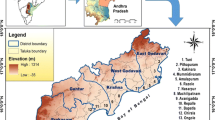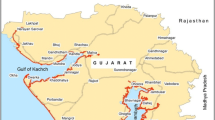Abstract
Climate change and its association with sea level rise ‘SLR’ have become a true fact that increasingly challenge coastal zones all over the world. This study attempts to fill the lack of studies and assessments of the African coasts through developing a SLR vulnerability assessment. The study has customized coastal vulnerability index ‘CVI’ to include seventeen parameters grouping in the vulnerability’s pillars: exposure, sensitivity, and resilience. The selected variables represent the main coastal characteristics physically and socioeconomically. The study applies CVI method for the African coastal zone using GIS and remote sensing. However, the study has followed the case study approach on the continental level of Africa, and the results have classified coastal areas into different degrees of vulnerabilities. Application of CEI equation showed that about 40% of African coast are ranging from moderate to very high exposure, as for the CSI equation showed that 75% of African coast are ranging from moderate to very high sensitivity, as for the CRI equation showed that 55% of African coast are ranging from moderate to very high resilience, and as for the CVI equation showed that 35% of the 26,000 km length of Africa’s coasts are vulnerable to SLR. It has been approved that deltas are the most vulnerable areas along the African coasts. Also, values of CVI pillars for each of these deltas showed great variation, which accordingly could give an indicator for adaptation and mitigation strategies of Africa’s coasts at regional and national levels, which could be one strategy or more: protection, accommodation, and retreat strategies.









Similar content being viewed by others
References
Change IPCC Climate. (2013). The physical science basis. The Working Group I contribution to the IPCC Fifth Assessment Report, Summary for Policy Makers. Geneva: Intergovernmental Panel on Climate Change.
Christian, R. R., & Mazzilli, S. (2007). Defining the coast and sentinel ecosystems for coastal observations of global change. Hydrobiologia, 577(1), 55–70.
Dinh, Q., Balica, S., Popescu, I., & Jonoski, A. (2012). Climate change impact on flood hazard, vulnerability and risk of the Long Xuyen Quadrangle in the Mekong Delta. International Journal of River Basin Management, 10(1), 103–120.
Dwarakish, G. S., Vinay, S. A., Natesan, U., Asano, T., Kakinuma, T., Venkataramana, K., et al. (2009). Coastal vulnerability assessment of the future sea level rise in Udupi coastal zone of Karnataka state, west coast of India. Ocean and Coastal Management, 52(9), 467–478.
FAO, W. R. B. (2007). World reference base for soil resources world soil resource. Reports FAO, ISRIC, ISSS, Rome.
Gornitz, V. M. (1991). Global coastal hazards from future sea level rise. Global and Planetary Change, 3(4), 379–398.
Gornitz, V. M., Daniels, R. C., White, T. W., & Birdwell, K. R. (1994). The development of a coastal risk assessment database: Vulnerability to sea-level rise in the US Southeast. Journal of Coastal Research, 12, 327–338.
Gornitz, V. M., White, T. W., & Cushman, R. M. (1991). Vulnerability of the US to future sea level rise. (No. CONF-910780-1). Oak Ridge National Lab., TN (USA).
Heberger, M., Cooley, H., Herrera, P., Gleick, P. H., & Moore, E. (2009). The impacts of sea-level rise on the California coast. Oakland, CA: Pacific Institute, California Climate Change Center for the State of California. CEC-500-2009-024-F.
Jahn, R., Blume, H. P., Asio, V. B., Spaargaren, O., & Schad, P. (2006). Guidelines for soil description. Rome: FAO.
Kumar, A. A., & Kunte, P. D. (2012). Coastal vulnerability assessment for Chennai, east coast of India using geospatial techniques. Natural Hazards, 64(1), 853–872.
Kuriqi, A., Pinheiro, A. N., Sordo-Ward, A., & Garrote, L. (2019). Influence of hydrologically based environmental flow methods on flow alteration and energy production in a run-of-river hydropower plant. Journal of Cleaner Production, 232, 1028–1042.
Martins, V. N., Pires, R., & Cabral, P. (2012). Modelling of coastal vulnerability in the stretch between the beaches of Porto de Mós and Falésia, Algarve (Portugal). Journal of Coastal Conservation, 16(4), 503–510.
Mather, A. A., Garland, G. G., & Stretch, D. D. (2009). Southern African sea levels: corrections, influences and trends. African Journal of Marine Science, 31(2), 145–156.
Musa, Z. N., Popescu, I., & Mynett, A. (2014). The Niger Delta’s vulnerability to river floods due to sea level rise. Natural Hazards and Earth System Sciences, 14(12), 3317–3329.
Nelson, A. (2008). Travel time to major cities: A global map of Accessibility. Ispra: European Commission.
Niang-Diop, I., Bosch, H., Burton, I., Khan, S. R., Lim, B., & North, N. (2005). Formulating an adaptation strategy. In B. Lim, E. Spanger-Siegfried, I. Burton, E. Malone, & S. Huq (Eds.), Adaptation policy frameworks for climate change: Developing strategies, policies and measures (pp. 183–204). Cambridge, UK, 2004: United Nations Development Programme (UNDP) and Cambridge University Press.
Özyurt, G., & Ergin, A. (2009). Application of sea level rise vulnerability assessment model to selected coastal areas of Turkey. Journal of Coastal Research, 56, 248–251.
Pendleton, E. A., Barras, J. A., Williams, S. J., & Twitchell, D. C. (2010). Coastal vulnerability assessment of the Northern Gulf of Mexico to sea-level rise and coastal change. US Geological Survey. Open-File Report 2010–1146.
Small, C., & Nicholls, R. J. (2003). A global analysis of human settlement in coastal zones. Journal of Coastal Research., 19, 584–599.
Thieler, E. R., & Hammar-Klose, E. S. (1999). National assessment of coastal vulnerability to sea-level rise; US Atlantic Coast (No. 99-593).
Unicef, & W. H. O. Unaids. UNFPA. (2009). Children and AIDS: Fourth stocktaking report. New York, NY: UNICEF.
Yin, J., Yin, Z., Wang, J., & Xu, S. (2012). National assessment of coastal vulnerability to sea-level rise for the Chinese coast. Journal of Coastal Conservation., 16(1), 123–133.
Author information
Authors and Affiliations
Corresponding author
Additional information
Publisher's Note
Springer Nature remains neutral with regard to jurisdictional claims in published maps and institutional affiliations.
Rights and permissions
About this article
Cite this article
El-Shahat, S., El-Zafarany, A.M., El Seoud, T.A. et al. Vulnerability assessment of African coasts to sea level rise using GIS and remote sensing. Environ Dev Sustain 23, 2827–2845 (2021). https://doi.org/10.1007/s10668-020-00639-8
Received:
Accepted:
Published:
Issue Date:
DOI: https://doi.org/10.1007/s10668-020-00639-8




